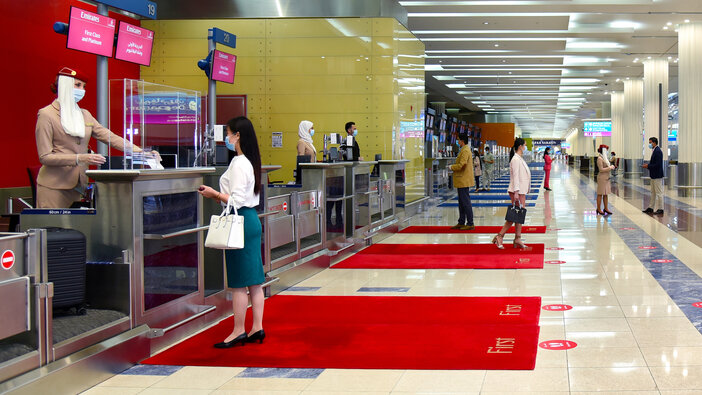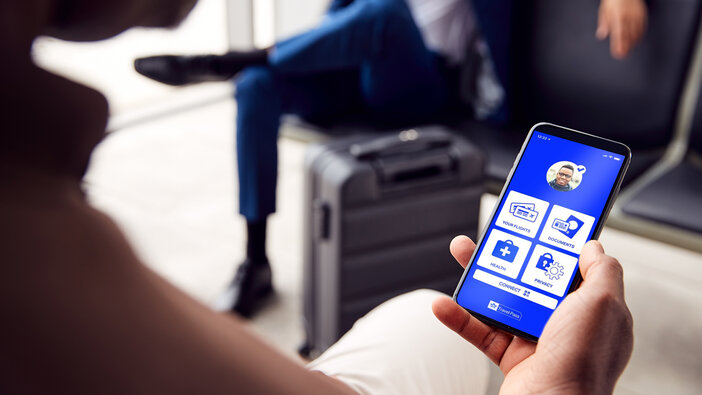A 51% reduction in seats offered by airlines. Around 2.8 billion fewer passengers. A potential loss of US$391bn in gross passenger operating revenues of airlines. ICAO’s estimated impact of the Covid-19 pandemic on the airline industry in 2020 is huge. And with recent chaotic scenes at Heathrow Airport when the UK government announced all arriving passengers needed verified negative Covid test results, it seems the road to recovery may be difficult. But there is hope. Along with the global vaccination program being rolled out this year comes an initiative from IATA that is set to revolutionize the way we travel. IATA’s Travel Pass, which will be trialled by British Airways, Emirates, Etihad Airways and Singapore Airlines prior to a full rollout of the solution in March 2021, will enable passengers to quickly and easily show they are Covid negative in order to travel.
How does it work?
“The IATA solution is based on two different parts: identity management and transfer of the test results,” explains Alan Murray Hayden, head of airport, passenger and security products at IATA. “Passengers will download either the IATA Travel Pass app or the airline’s app – which has Travel Pass integrated – and create their own digital passport by taking a picture of their face, completing a liveness test [such as closing their eyes in front of the camera] and then scanning the data-chip on the physical passport. The IATA Travel Pass then verifies that the passport is genuine and belongs to the person in front of the phone, and is then stored on the passenger’s phone as their ‘digital passport’.
“They will then go to an authorized lab or test center – and we will be providing technology to these facilities to enable this process – and scan a QR code that will create a link between the passenger’s phone and the lab, and the lab will verify that this is the correct person. At that point, the passenger’s identity on the laboratory side is deleted so there are no GDPR issues. As soon as the Covid test results are available they are sent to the passenger’s phone. It is really simple for the passengers.”
The app will also link to IATA’s Timatic database, which holds all the immigration regulations from every country in the world and is updated daily. This will enable the passenger’s test results to be cross-checked with the regulations in the destination to which they wish to travel. If they meet the requirements, the passenger will receive an ‘okay to travel’ status on their phone. “The passenger can then share the results with the airline electronically. There is a huge amount happening in the background, but from a passenger perspective it takes just a couple of clicks on their phone,” Hayden enthuses.

In some cases, governments may require proof of vaccine for entry, and IATA Travel Pass is being designed to manage this. Once vaccinated, passengers will be able to show their vaccination status, although this is still a work in progress because IATA needs to work out how to share each passenger’s vaccination status digitally. Hayden explains, “When you’re talking about test results, we can work with the test labs in different countries because they are commercial organizations and if you want to travel you will probably go to one of the private labs to get your test done. When it comes to vaccination, you’ll be vaccinated by the doctor or your government and so the question is how can that government transfer the results to you as a passenger in a way in which everyone can have confidence? Some of my team are sitting on a WHO group on this to try and find an electronic version of the vaccination certificate.”
However, Hayden is confident a solution will be found and believes the IATA Travel Pass will be the key to reopening the skies after the Covid pandemic. “It will change the way we travel – I will share my identity and vaccination status in advance so when I arrive at the airport, I just walk through security using my face, and the same with the self-boarding gates to get on the plane. Because it is linked to passenger identity, the IATA Travel Pass solution will really enable this type of touch-free, efficient travel for the future, even when Covid has gone.”
Getting the solution up and running
IATA began working on a solution to the Covid travel bans almost as soon as the pandemic hit, because the quarantine rules put in place by governments were strangling the aviation industry. “For example, for one of the big British airlines, when there were quarantine rules in place for the Canary Islands their flight levels were at 3%. When they lifted the quarantine rules, flight levels were 97%. So, quarantine is really what is stopping anyone traveling,” Hayden says. “On the other hand, testing is exactly what makes travel possible. And people are prepared to get tested, so it really is the short-term solution for aviation.”
According to Hayden, another big challenge that had to be overcome was ensuring confidence in the testing system. With a proliferation of fake tests that can be bought over the internet, there needed to be a way to reassure governments, airlines and passengers that the test results were official and easy to process.
“At the moment, airlines can’t process the passengers – all the checking that is being done at the airport is taking up way too much time,” Hayden explains. “For example, Heathrow is operating at 5-10% of its normal capacity but it has more check-in agents on duty at the moment than it does on its busiest day of the summer. Airports are effectively operating at full capacity right now with just 5-10% of the usual passenger numbers; there are queues out the door, so as soon as we get things up and running again, we’re not going to be in a place to cater to that.
“The two key challenges are people having confidence in testing and ultimately the vaccine regime, and the ability to automatically verify that the passengers meet the requirements before they arrive at the airport. Those two things are what will allow our industry to open up again.”
Several providers are coming up with solutions, but none are focused on what the aviation industry and passengers need, according to Hayden. “So, a number of different CEOs of airlines approached our director general and said, ‘IATA needs to create a solution that is based around the customers
and current operational processes in airlines.’ And that is what we’re bringing to the table. Travel Pass is a solution that fits in with how airlines operate today and is implementable; it is also based around the needs of passengers.”

Working together
To ensure the security of passengers’ confidential data, IATA is working with Evernym, a provider of sovereign blockchain technology. Sovereign blockchain enables the owner of the data – in this case the passenger – to be in full control of their data without it being held in a central database, so there is no risk of a security breach and the owner’s identity being stolen. IATA is also open to working with anyone in the aviation sector to enable the industry to get back up and running. About 20 airlines have requested to trial the solution and another 40 or 50 have expressed interest. Hayden continues, “The airlines are looking at all the solutions out there and testing the different providers. I’m pretty confident once they see our solution, they will choose it.”
Cost-wise, the app will be free to passengers and governments, with a small fee charged to airlines, but this will be “cents rather than dollars” according to Hayden. He adds, “Airports won’t need to invest in anything. In reality, there isn’t actually a huge role for airports to play in the verification of testing; it is the airlines and the immigration authorities checking all the test results. If the airlines want to use the biometric process and the facial matching, they would need to have the technology at their airports, but that is the second step down the road.”
During the trial period, airlines will use the Travel Pass on a couple of different routes, but Hayden says this has also presented challenges. “It is one of the lessons we’ve learned: regulations keep on changing the whole time, so we’ve actually had to change the pilots a couple of times,” he explains. “Now we’ve made the pilots as flexible as possible, so if we shut down one route, we can switch to another in the morning. The airlines all have their own independent objectives, which are confidential, but there are specific metrics we have set up for the solution in terms of number of passengers and processing time. The whole idea is to make the processing of passengers as quick and easy as possible.”
The future of air travel
For Hayden, the IATA Travel Pass represents the future of air travel in a post-Covid world. “I think the concept of having an electronic version of your passport will be key – and that has been approved by ICAO, so this is the way governments want to go too,” he comments. “We were actually working on this before Covid through the initiative of One ID, which was IATA’s group to promote this type of technology. We were working on an app called IATA Contactless Travel, which was all about creating the electronic passport and then sharing it with airports and airlines. That is what we’ve morphed into the IATA Travel Pass. We’ve built the whole Covid solution on top of existing work.”
Hayden concludes, “I want to make people fall in love with traveling like we did as kids, I want people to feel that awe at traveling again. That is really what contactless travel will enable – you will be able to go to an airport and you won’t have to queue, you won’t be treated like cattle, you will just walk up to security and facial recognition will mean you’ll walk right through. Air travel should become much more pleasant, and that really will be the legacy of this initiative.”
This article was originally published in the April 2021 issue of Passenger Terminal World.

